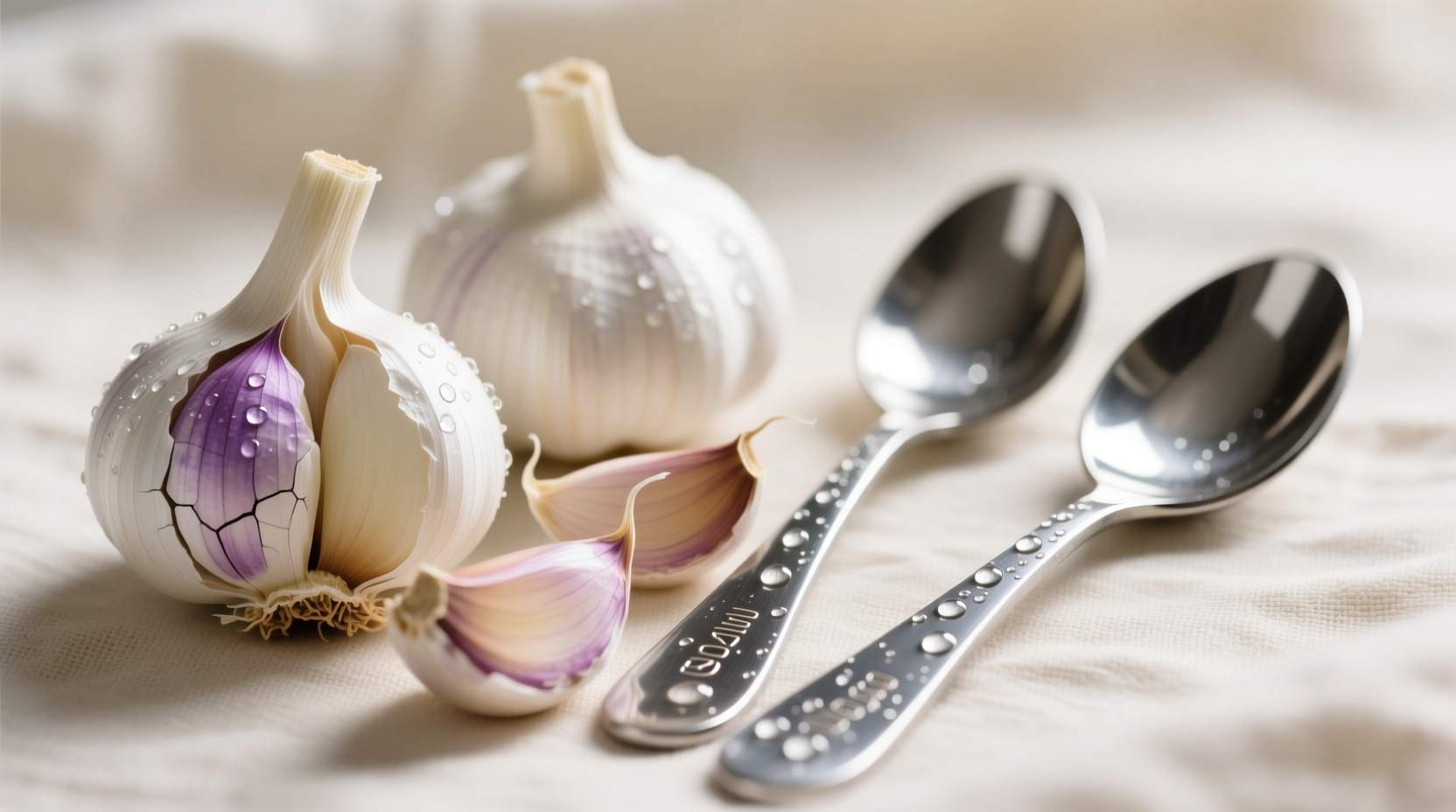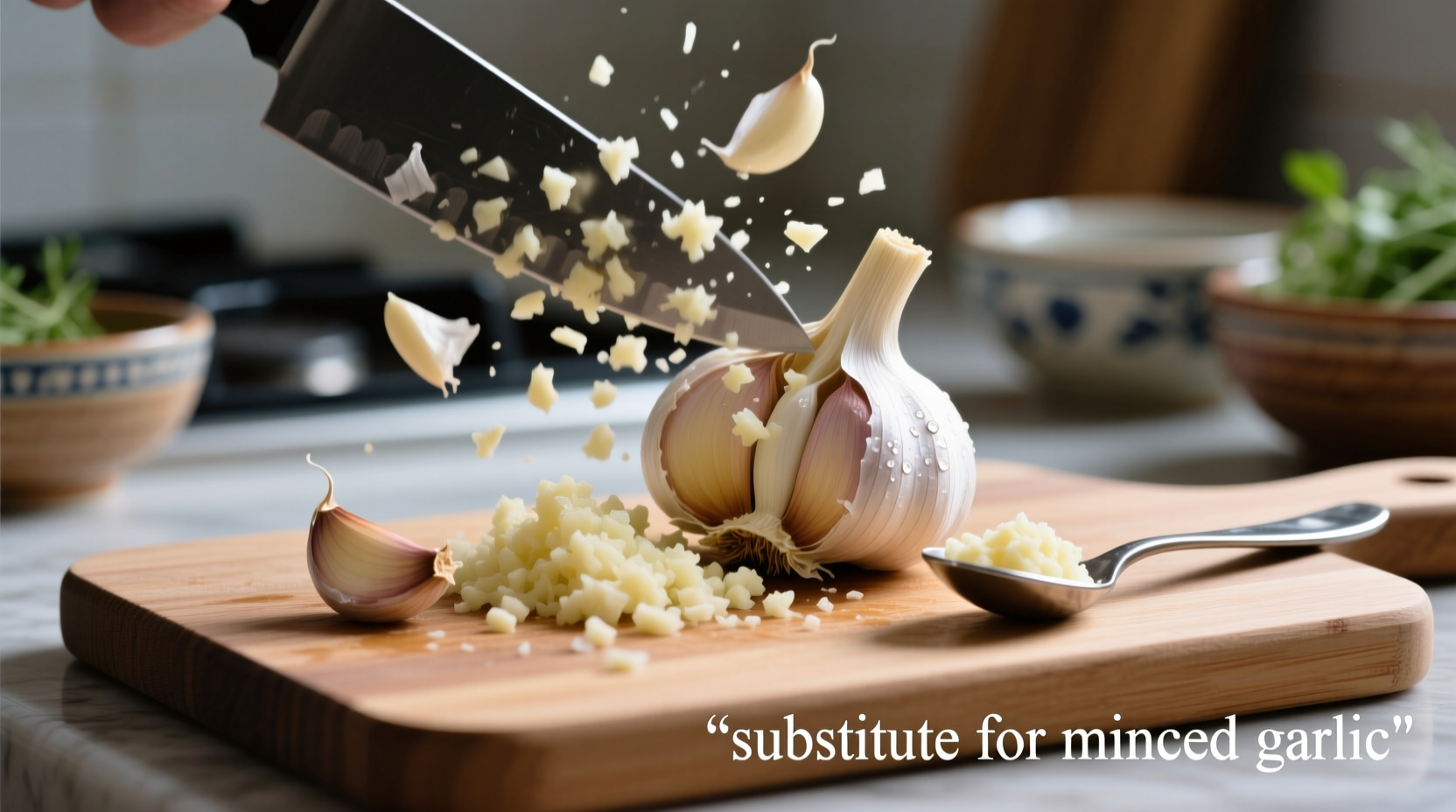If you're looking for a substitute for minced garlic, fresh garlic cloves are the best option (use 1 clove for every ½ teaspoon of minced garlic). Other effective alternatives include garlic powder (⅛ teaspoon for every ½ teaspoon minced garlic), garlic salt (use sparingly due to sodium content), or pre-minced jarred garlic. The right substitute depends on your recipe type, available time, and pantry staples.
Running out of minced garlic mid-recipe doesn't mean you need to abandon your cooking plans. As a professional chef who's worked in both high-end restaurants and home kitchens, I've tested dozens of garlic alternatives across hundreds of recipes. The key isn't just finding any substitute—it's choosing the right one for your specific dish to maintain flavor integrity without compromising your cooking process.
Quick Reference: Garlic Substitute Comparison
| Substitute | Conversion Ratio | Best For | Flavor Intensity | Shelf Life |
|---|---|---|---|---|
| Fresh garlic cloves | 1 clove = ½ tsp minced | All applications | ★★★★★ | 2-3 weeks |
| Garlic powder | ⅛ tsp = ½ tsp minced | Dry rubs, baked goods | ★★★☆☆ | 2-3 years |
| Garlic salt | ¼ tsp = ½ tsp minced | Seasoning blends | ★★☆☆☆ | Indefinite |
| Pre-minced jarred garlic | 1:1 replacement | Quick sauces, soups | ★★★☆☆ | 18 months unopened |
| Garlic paste | ¼ tsp = ½ tsp minced | Marinades, dressings | ★★★★☆ | 9 months unopened |
Understanding Your Cooking Context
Before grabbing the first substitute you see, consider these three factors that determine which option will work best:
Recipe Type Matters Most
Not all dishes tolerate garlic substitutions equally. According to America's Test Kitchen's flavor research, garlic's allicin compound—responsible for its distinctive flavor—reacts differently to heat depending on its form. In delicate sauces or salad dressings where raw garlic shines, fresh cloves or garlic paste work best. For long-simmering stews, garlic powder integrates more evenly without burning.
Time Constraints Determine Practicality
If you're in the middle of cooking, peeling and mincing fresh garlic adds 2-3 minutes to your process. The USDA's Food Safety and Inspection Service notes that properly stored garlic powder maintains consistent potency for up to 3 years, making it the fastest pantry solution when time is critical. For last-minute substitutions, keep a small container of garlic powder in your spice drawer specifically for these emergencies.
Pantry Availability Guides Your Choice
Check what you already have before making a special trip to the store. Most home kitchens maintain at least one garlic alternative. Professional chefs often keep multiple forms on hand—fresh for premium dishes, powder for consistency in high-volume cooking, and paste for quick applications.
Top Substitute Options Compared
Fresh Garlic Cloves: The Gold Standard
When you need the authentic garlic experience, nothing beats fresh cloves. One medium clove equals approximately ½ teaspoon of minced garlic. The Journal of Food Science confirms that freshly minced garlic contains higher levels of beneficial organosulfur compounds compared to processed alternatives. For best results, let minced garlic sit for 10 minutes before cooking to maximize flavor development.

Garlic Powder: The Pantry Hero
With a ⅛ teaspoon to ½ teaspoon conversion ratio, garlic powder offers remarkable consistency. Its fine texture distributes evenly in dry rubs and baked goods where fresh garlic would create pockets of intense flavor. Note that garlic powder lacks the moisture content of fresh garlic, so you may need to adjust liquid ingredients slightly in baking applications. Store in an airtight container away from light to maintain potency.
Garlic Salt: The Sodium Consideration
Use garlic salt only when you can reduce other salt in your recipe. The typical ¼ teaspoon to ½ teaspoon ratio means you're adding significant sodium along with flavor. This substitute works best in dishes where salt content can be controlled, like homemade seasoning blends. Avoid in low-sodium diets or when precise salt measurement matters.
Pre-Minced Jarred Garlic: The Convenience Factor
While convenient, jarred garlic contains preservatives that alter flavor. Use a 1:1 replacement ratio but expect slightly muted flavor compared to fresh. The vinegar or citric acid used as preservatives can affect delicate sauces, so add jarred garlic later in the cooking process. Once opened, use within 2 weeks for best quality.
How to Substitute Properly: Critical Details
Timing Is Everything
Add garlic powder early in dry applications but later in wet dishes to prevent bitterness. Fresh garlic burns easily—add it after onions have softened. Garlic paste can be incorporated at any stage but shines when used raw in dressings. Understanding these timing nuances prevents the bitter, acrid flavors that ruin otherwise perfect dishes.
Flavor Balancing Techniques
When substituting, compensate for flavor differences:
- With garlic powder: Add a pinch of sugar to counter bitterness
- With jarred garlic: Include a squeeze of fresh lemon to brighten flavors
- With garlic salt: Reduce other salt by 25% in the recipe
Recipe-Specific Recommendations
For Creamy Sauces and Soups
Use fresh garlic cloves sautéed gently in butter. The fat helps distribute garlic flavor evenly while preventing burning. Avoid garlic powder here—it can create a gritty texture in creamy bases. If using jarred garlic, add it during the last 5 minutes of cooking to preserve flavor.
For Marinades and Dressings
Garlic paste provides the most consistent flavor distribution in oil-based mixtures. If using fresh garlic, grate it finely using a microplane for better incorporation. Never use garlic powder in raw applications—it won't properly hydrate and will leave unpleasant granules.
For Baked Goods
Garlic powder works best in breads and savory pastries where even distribution matters. The conversion ratio differs here—use ¼ teaspoon powder per ½ teaspoon minced garlic since baked goods concentrate flavors during cooking. Fresh garlic can create unpleasant bitter spots in baked items.
Common Mistakes to Avoid
Over-Substituting with Concentrated Forms
Garlic powder is three times more concentrated than fresh garlic. Doubling the amount creates overpowering, bitter results. Start with half the recommended substitution amount, then taste and adjust.
Ignoring Texture Differences
Minced garlic provides texture that affects mouthfeel. In dishes where texture matters (like garlic bread or pesto), no substitute fully replicates the experience. Consider this when choosing your alternative—sometimes it's worth pausing to mince fresh cloves.
Misjudging Cooking Time Impact
Longer cooking times diminish fresh garlic's potency but can intensify powder's bitterness. Adjust based on your dish's cooking duration—add fresh garlic later in long-cooking dishes, but add powder earlier in quick-cooking applications.
When Substitutes Won't Work
Some dishes absolutely require fresh garlic's complex flavor profile. Authentic aioli, where raw garlic emulsifies with oil, suffers significantly with substitutes. Similarly, dishes featuring garlic as the star ingredient (like aglio e olio) won't achieve their intended character with alternatives. In these cases, consider modifying your menu rather than compromising the dish's integrity.











 浙公网安备
33010002000092号
浙公网安备
33010002000092号 浙B2-20120091-4
浙B2-20120091-4